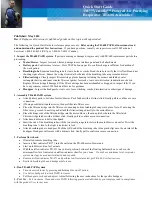
17
Assembling the indoor unit
Prior to assembling the indoor unit, observe the follow-
ing:
à
When assembling the indoor unit, make sure that the
required minimum distances are observed.
à
Assemble the indoor unit in such a way that conden-
sation drainage is not blocked and air can always
flow freely in and out of the unit.
à
The unit is attached by means of a wall mount.
à
The wall mount is attached with screws and dowels
suitable for the wall.
The dimensions of the individual unit types relevant
for attaching them can be found in the section
“Dimensions”.
Oil recirculation
If the outdoor part is set up at a higher level than the in-
door unit, appropriate steps must be taken for oil recir-
culation.
This is usually accomplished by creating an oil elevation
arc that is installed every 2.5 meters of line going up.
Example for Options 2 and 4
Disassembling the wall mount
To assemble the wall mount, parts of the housing panel
of the indoor unit must be disassembled.
1. Place the indoor unit with the backside facing up on
a soft surface.
2. Remove the left housing panel from the guiding
slots.
3. Proceed the same way to remove the right housing
panel from the guiding slots.
à
Prior to assembly, look at the possible drainage op-
tions (1 to 4) for refrigerant lines, condensation
hoses and control lines.
à
If the outdoor part is set up in a basement, an attic,
in adjoining rooms or halls, make sure that the warm
air can be adequately released.
à
Install an additional fan that has the same air volume
current at its disposal as the outdoor part set up in
the room which can potentially compensate for addi-
tional pressure losses through air channels.
Radius:
50 mm
Outdoor part
max. 5 or
8 m
Indoor unit
Oil elevation arc in the
suction line to the outdoor
part 1x for every 2.5 m
Option 1
Option 3
Option 2
Option 4
Light
shaft
additional
fan
outdoor
part
Warm air
Light
shaft
Warm air
Cold
fresh air












































